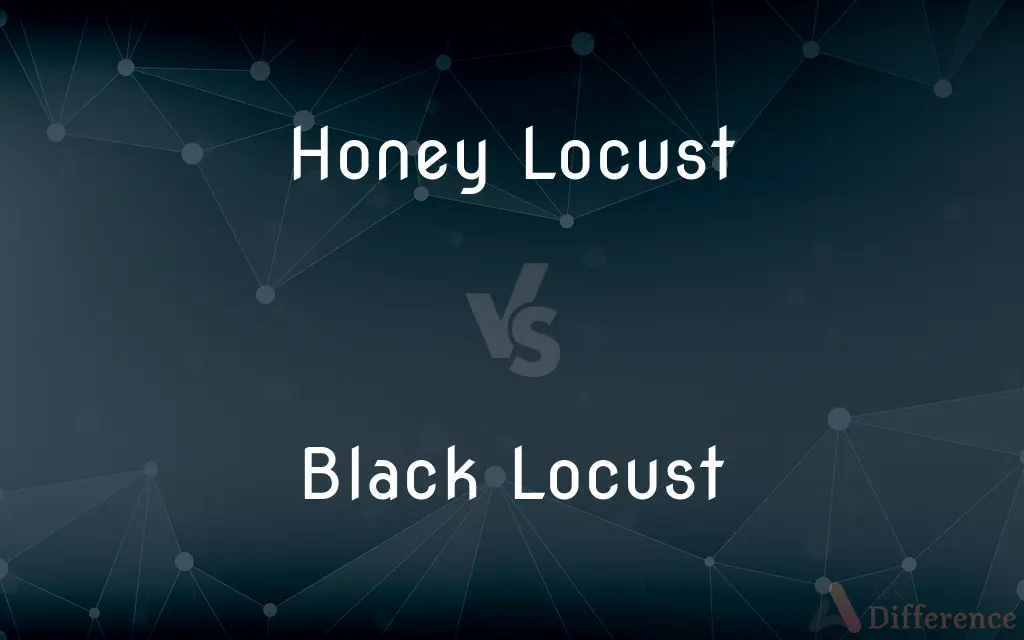Honey Locust vs. Black Locust — What's the Difference?
Edited by Tayyaba Rehman — By Maham Liaqat — Published on March 6, 2024
Honey locust trees are known for their feathery foliage and large, flat seed pods, while black locust trees are recognized for their strong wood and clusters of fragrant white flowers.

Difference Between Honey Locust and Black Locust
Table of Contents
ADVERTISEMENT
Key Differences
Honey locust (Gleditsia triacanthos) trees feature a lighter, more open canopy compared to the dense, leafy coverage of black locust (Robinia pseudoacacia) trees. This difference in foliage affects the amount of shade each tree provides, with honey locust offering dappled sunlight and black locust creating more substantial shade.
The thorns of these species are notable distinctions. Honey locusts can have large, branched thorns on their trunk and branches, making them somewhat intimidating, though thornless varieties are commonly planted in urban areas. Black locust trees have smaller, simpler thorns that are nonetheless sharp, primarily found on the younger trees or new growth.
In terms of flowering, black locust trees are admired for their attractive, fragrant white flower clusters that bloom in late spring. Honey locust trees, however, have less conspicuous flowers, which are followed by the distinctive flat, twisted seed pods that can litter the ground in autumn.
The wood of black locust is highly valued for its durability and resistance to rot, making it a popular choice for furniture, fencing, and small watercraft. Honey locust wood, while also durable, is not as commonly used for these purposes due to its less consistent density and hardness.
Environmental adaptability shows another contrast; honey locust trees are extremely tolerant of urban pollution, poor soils, and drought conditions, making them favorites for city landscaping. Black locust, while also resilient, is considered invasive in some regions due to its aggressive root system and rapid growth, which can outcompete native vegetation.
ADVERTISEMENT
Comparison Chart
Foliage
Feathery, offers dappled sunlight.
Dense, provides substantial shade.
Thorns
Large and branched (though thornless varieties exist).
Smaller, sharp, mainly on younger trees.
Flowers
Less conspicuous, not a major feature.
Fragrant white clusters, visually appealing.
Seed Pods
Large, flat, and twisted, littering the ground in autumn.
Smaller, more contained, less troublesome.
Wood Usage
Less commonly used, not as durable.
Highly valued for durability and rot resistance.
Environmental Tolerance
Highly tolerant of urban conditions and drought.
Tolerant but can be invasive, with aggressive growth.
Compare with Definitions
Honey Locust
Less commonly used for timber due to variability in wood characteristics.
While beautiful, honey locust wood is not as popular for outdoor furniture.
Black Locust
Features dense foliage and sharp thorns on young growth.
The dense canopy of the black locust provided excellent shade for the backyard.
Honey Locust
A tree known for its open canopy and large seed pods.
The park's pathways were lined with honey locust trees, providing gentle shade.
Black Locust
Wood is highly resistant to rot, ideal for outdoor use.
Black locust wood was the preferred material for the new fence due to its longevity.
Honey Locust
Produces flat, twisted seed pods in autumn.
In the fall, the ground beneath honey locust trees was covered with their distinctive seed pods.
Black Locust
Considered invasive in some areas due to rapid growth.
Efforts were made to control the spread of black locust trees in the nature reserve.
Honey Locust
Often planted in urban areas for its tolerance to pollution.
Honey locusts were chosen for the street landscaping due to their resilience.
Black Locust
A tree valued for its durable wood and fragrant flowers.
The black locust's white flowers added beauty and fragrance to the garden.
Honey Locust
Can have large, intimidating thorns, though thornless varieties are common.
The thornless honey locusts were a safe choice for the schoolyard.
Black Locust
Flowers attract bees and are beneficial for pollinators.
The blooming black locust trees were always abuzz with bees in spring.
Common Curiosities
Are the thorns on honey locust trees dangerous?
The thorns on some honey locust trees can be large and sharp, posing a risk, though thornless varieties are commonly used in public spaces to mitigate this danger.
How fast do black locust trees grow?
Black locust trees grow quickly, making them a fast option for achieving mature landscapes.
Do honey locust trees require a lot of water?
No, honey locust trees are drought-tolerant and do not require a lot of water once established.
Is it easy to care for a black locust tree?
Black locust trees are relatively low-maintenance but managing their rapid growth and potential invasiveness may require effort in some regions.
Can honey locust trees grow in poor soil?
Yes, honey locust trees are highly adaptable and can thrive in poor soil conditions.
Are black locust trees good for landscaping?
Black locust trees can be good for landscaping, offering dense shade and attractive flowers, but their invasiveness and thorns may be considerations.
What wildlife is attracted to honey locust trees?
Honey locust trees can attract wildlife, including birds and small mammals, which may feed on the seeds.
Can honey locust seed pods be a nuisance?
Yes, the large, flat seed pods of the honey locust can litter the ground in autumn, requiring cleanup in landscaped areas.
Why is black locust wood so valued?
Black locust wood is extremely durable and resistant to rot, making it ideal for outdoor applications like furniture and fencing.
Are black locust flowers edible?
Yes, black locust flowers are edible and have been used in traditional culinary applications, known for their sweet fragrance.
Share Your Discovery

Previous Comparison
Chrome vs. Safari
Next Comparison
Jeep Wrangler Sahara vs. Jeep Wrangler SportAuthor Spotlight
Written by
Maham LiaqatEdited by
Tayyaba RehmanTayyaba Rehman is a distinguished writer, currently serving as a primary contributor to askdifference.com. As a researcher in semantics and etymology, Tayyaba's passion for the complexity of languages and their distinctions has found a perfect home on the platform. Tayyaba delves into the intricacies of language, distinguishing between commonly confused words and phrases, thereby providing clarity for readers worldwide.
















































